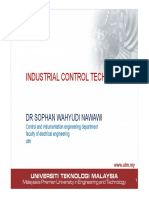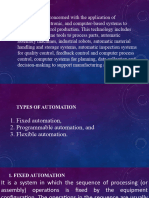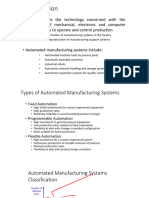0% found this document useful (0 votes)
60 views38 pagesIntroduction To Automation
The document outlines the concept of automation, categorizing it into manufacturing and service automation, with examples including robots and CNC machines. It details three types of automation: fixed, programmable, and flexible, each with distinct characteristics and production capabilities. Additionally, it discusses production types such as job shop, batch, and mass production, highlighting the attributes and advantages of each automation type.
Uploaded by
Dan VillanuevaCopyright
© Attribution Non-Commercial (BY-NC)
We take content rights seriously. If you suspect this is your content, claim it here.
Available Formats
Download as PDF, TXT or read online on Scribd
0% found this document useful (0 votes)
60 views38 pagesIntroduction To Automation
The document outlines the concept of automation, categorizing it into manufacturing and service automation, with examples including robots and CNC machines. It details three types of automation: fixed, programmable, and flexible, each with distinct characteristics and production capabilities. Additionally, it discusses production types such as job shop, batch, and mass production, highlighting the attributes and advantages of each automation type.
Uploaded by
Dan VillanuevaCopyright
© Attribution Non-Commercial (BY-NC)
We take content rights seriously. If you suspect this is your content, claim it here.
Available Formats
Download as PDF, TXT or read online on Scribd
/ 38























































